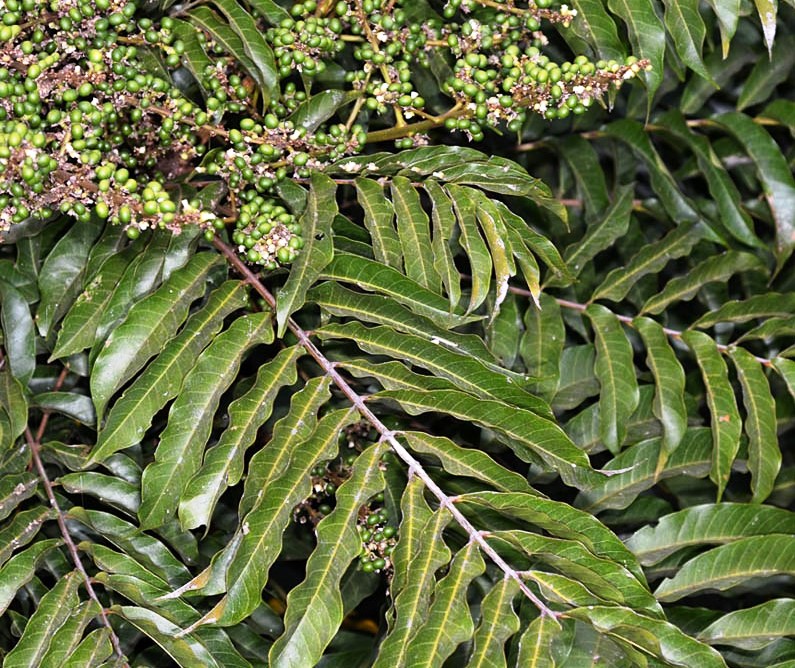Deinbollia pinnata

|
|
Deinbollia pinnata Common Names: Water Willow, Soap Berry, Cape Ash Scientific
Classification Kingdom: Plantae Clade: Tracheophytes Clade: Angiosperms Clade: Eudicots Clade: Rosids Order: Sapindales Family: Sapindaceae Genus: Deinbollia Species: D. pinnata Binomial Name: Deinbollia pinnata (Poir.) Schumach. & Thonn. Synonyms: Deinbollia dahomensis A.Chev., Deinbollia elliotii Gilg, Deinbollia leptophylla Gilg & Radlk., Ornitrophe pinnata Poir., Prostea pinnata (Poir.) Cambess., Sapindus guineensis G.Don, Schmidelia pinnata (Poir.) DC. Morphological Description Deinbollia pinnata is a small tree or shrub, typically 3–10 m tall,
occasionally reaching 15 m. Key features include: · Stem: Woody, glabrous or slightly grey-downy, branching freely,
bark smooth to scaly, greyish-brown · Leaves: Pinnate, 15–30 cm long, with 5–6 pairs of oblong leaflets
(7–10 cm long, 3–5 cm wide), acute apex, coriaceous, pale green · Flowers: Small, greenish-white, 3–5 mm across, in axillary or
terminal panicles, blooming in rainy seasons · Fruit: Globose drupe, 1–2 cm diameter, yellow-orange when ripe,
containing 1–2 seeds Distribution and Habitat Deinbollia pinnata is native to West and Central Africa, ranging from Senegal
to Cameroon and south to Angola. It thrives in: · Regions: Rainforests, secondary forests, savanna woodlands,
riverbanks · Climate: Tropical, 25–35°C, rainfall 1,200–2,500 mm annually · Soil: Well-drained, loamy to sandy, pH 5.0–6.5 · Elevation: Sea level to 1,200 m It adapts to both shaded
understories and open, disturbed areas (Burkill, 2000). Ethnopharmacology Deinbollia pinnata is widely used in African traditional medicine, with studies
validating its applications: · Antimicrobial: Root extracts and isolated compounds demonstrated in-vitro
antibacterial activities against four multidrug resistant Gram positive
bacterial strains: Streptococcus pneumoniae, Staphylococcus aureus,
Staphylococcus albus, Staphylococcus epidermidis and three Gram-negative
bacterial strains: Escherichia coli, Pseudomonas aeruginosa, and Klebsiella
pneumonia using disc diffusion method for the assay. The diameter zone of
inhibition ranges from 5 mm – 20 mm. In each case, the standard drugs,
gentamycin, ceftriaxone and ofloxacin are more active than the extracts and
isolated compounds. (Lasisi et al., 2016). · Insecticidal
Activity: The essential oil, at a
concentration of 120 mg/mL, displayed 100% mortality against Sitophilus zeamais
at 72 h with a LC(50) > 40.00 mg/mL air (Sotubo, et al., 2015). · Anti-inflammatory: Bark decoctions in Ghana reduce swelling;
ethanol extracts inhibit edema in rats (45% at 300 mg/kg) (Ofori et al., 2021). · Analgesic: Roots are used to relieve pain; · Antioxidant: P. pinnata possessed strong scavenging activity and moderate
reducing power. The total phenol, flavonoid, and proanthocyanidin contents of
the extracts were very close to those reported for most medicinal plants and
showed good correlation with its antioxidant activities. These properties are
probably part of the reasons why P. pinnata is effective in folk medicine. (Jimoh
et al., 2007). · Gastroprotective: Bark is used to treats ulcers. ⚠ Toxicity Profile: No acute toxicity at traditional doses; LD₅₀
> 5,000 mg/kg in rats (safe orally). High doses may cause mild GI distress
due to saponins (Ofori et al., 2021). Additional Uses · Ecological: Provides shade, stabilizes soil, supports biodiversity · Economic: Leaves as soap substitute; wood for fuel and small tools · Cultural: Used in rituals in Nigeria (e.g., cleansing ceremonies) · Ornamental: Climbing habit enhances tropical landscapes References
External Links More Pictures |
|
| Compounds of Deinbollia pinnata | |
| References |